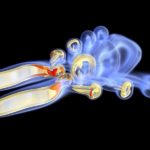News, Bio-Inspired Underwater Devices & Swarming Algorithms for Robotic Vehicles
MIT ocean and mechanical engineers are using advances in scientific computing to tackle challenges such as microplastics, algae blooms, coral bleaching, and rising temperatures.
The team is developing and using numerical simulation approaches to explore the design space for underwater devices that have an increase in degrees of freedom, for instance due to fish-like, deformable fins. Using swarming technology, they also test how vehicles periodically communicate its location to other vehicles nearby. This software enables these vehicles to disperse in an optimal distribution for the portion of the ocean in which they are operating. Their goal is to develop higher-performing underwater devices, and improve ocean modeling and predictions.
“Fish have intricate internal musculature to adapt the precise shape of their bodies and fins. This allows them to propel themselves in many different ways, well beyond what any man-made vehicle can do in terms of maneuverability, agility, or adaptivity,” said Wim van Rees, the ABS Career Development Professor at MIT.
Learn about our two Decals!
 Click here to find out more about our Fall Bioinspired Design Decal and our Spring Bioinspired Design in Action Decal – ALL MAJORS are welcome.
Click here to find out more about our Fall Bioinspired Design Decal and our Spring Bioinspired Design in Action Decal – ALL MAJORS are welcome.Berkeley BioDesign Community
 Click here to learn about the BioD: Bio-Inspired Design @ Berkeley student organization or here to signup for more info.
Click here to learn about the BioD: Bio-Inspired Design @ Berkeley student organization or here to signup for more info.Search
Student Login





I imagine that the neurological circuits underlying these processes are governed by both 2d spacing maps with their brains as…
to reduce the impact of car accidents, it may be possible to study the force diverting physics of cockroaches to…
you see this type of head-bobbing stability in many avian creatures related to pigeons like chickens. the head ability to…
not like they taught horses how to run! this is an example of convergent evolution where both sea creatures and…
The brain functions in a similar way with neuronal connections. our brains are able to utilize the multiplicity of connections…